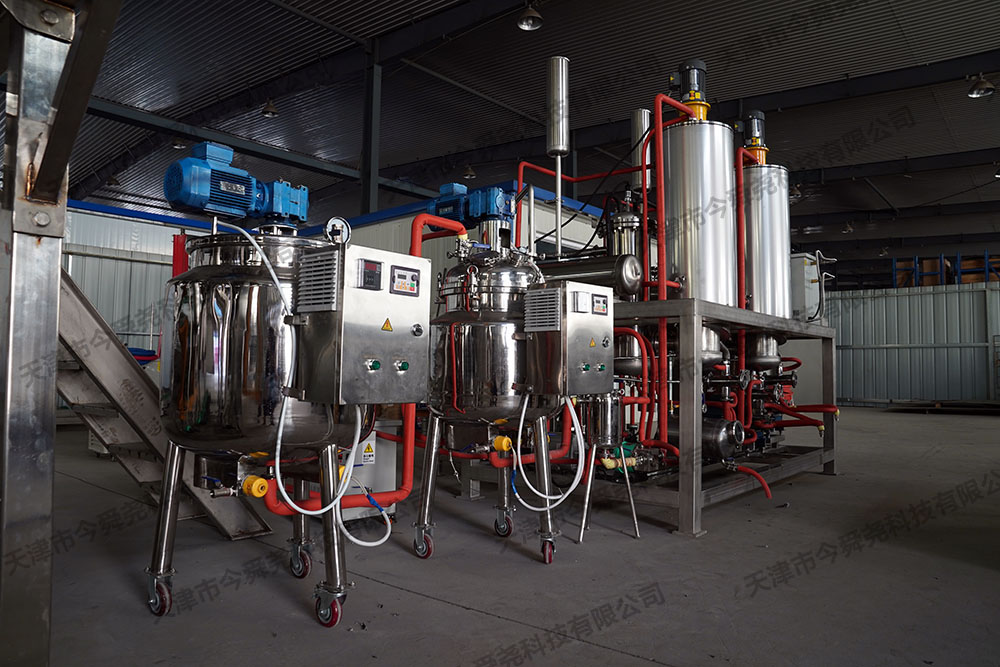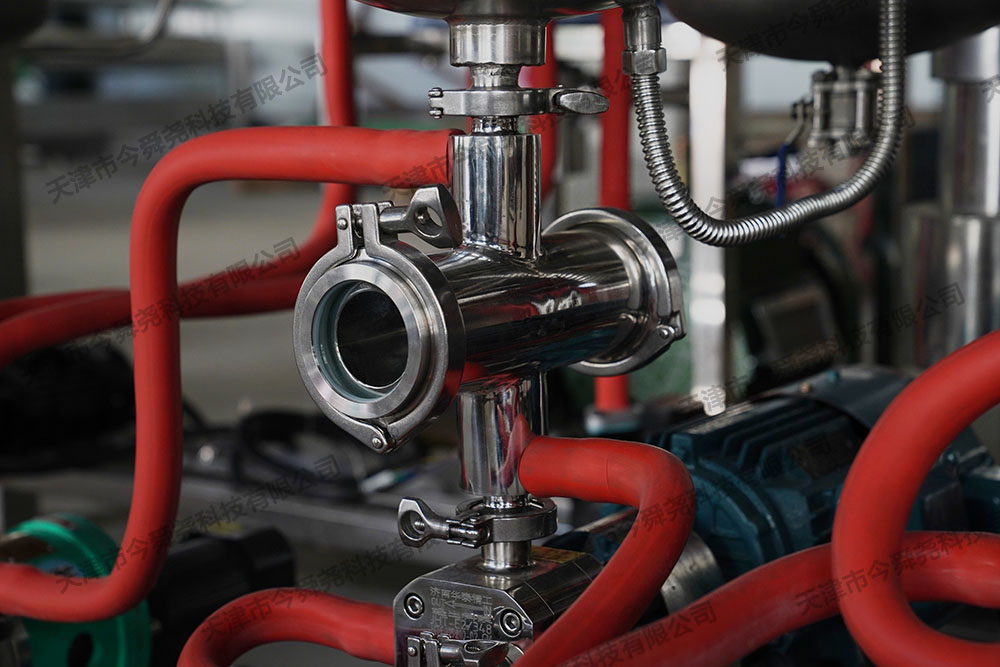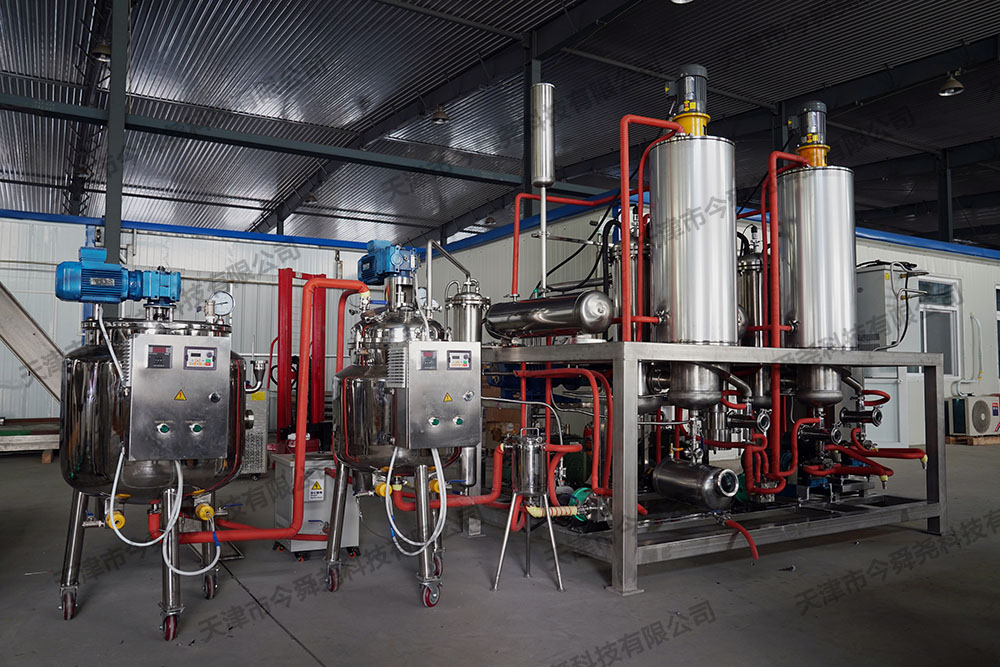Molecular distillation apparatus
The whole process equipment of molecular distillation
Product Description:
According to the U.S. fish oil industry department's estimates, the investment scale for fish oil-related equipment will reach $3.8 trillion to $5 trillion annually over the next five years. As fish oil markets in other countries gradually open up, this timeline will be extended further. Currently, most extraction equipment used by American manufacturers is provided by China, with annual imports from China reaching tens of billions of dollars and increasing year by year. However, U.S.-made equipment only supports the front-end part of the production line and cannot sustain the refining and purification processes of the entire production line, and the prices are relatively high. Our company's equipment is independently developed, highly cost-competitive, and features exquisite craftsmanship, making it highly favored by customers.
Product Example:
The equipment shown in the video is the latter half of the fourth production line customized for a company in Seattle, USA. The first half of the production line is considered confidential and cannot be photographed, but the related technical support is provided by our company.
The production process is roughly as follows: raw materials are extracted using advanced low-temperature centrifugal extraction technology, which ensures high extraction rates and minimal alcohol residue, resulting in an alcohol and fish oil solution. After alcohol evaporation and concentration, crude oil and recovered alcohol are obtained. The recovered alcohol is refined through a distillation column to ensure a certain concentration before being reused. Crude oil contains various impurities, some of which form gel-like substances during the later refining process. These substances undergo molecular structural changes when exposed to high temperatures, which is the main cause of equipment failure and instability. Our company has conducted comprehensive research on raw materials from the U.S., Canada, Colombia, and other regions, identifying common causes and specifically addressing the removal of harmful impurities with specialized processes and equipment tailored to the U.S. market. This has completely eliminated common issues such as clogging, coking, equipment failure, and even equipment scrapping.
Based on our in-depth research on fish oil raw materials, we discovered that natural fish oil contains not only EPA but also a large amount of DHA. Under certain conditions, DHA can be converted into EPA. Leveraging this discovery, we developed a specialized conversion device. The first device from the left in the video is the DHA conversion device. After conversion, the EPA content is increased, so using this technology can improve yield. During the DHA conversion process, water and carbon dioxide are produced. The second reactor from the left is the device used to remove water and carbon dioxide. This technology is a core patented research achievement of our company. As a result, our products perfectly address the common industry issues of equipment instability and vacuum system damage. Any unconverted DHA undergoes a minor conversion reaction in subsequent molecular distillation equipment, producing water and carbon dioxide that can severely damage the vacuum system, causing equipment issues after a short period of operation. Clearly, our products do not have such problems.
The part of the video showing the product output features one of our core devices: the molecular distillation equipment. This equipment is used to separate the raw material after harmful substances have been removed. The first separation removes volatile aromatic terpenes and olefin liquids, while the second removes chlorophyll, fats, and other colored impurities. The Seattle client has agreed to adopt our company's recommendation to use two-stage molecular distillation equipment in the future to obtain high-concentration EPA or DHA products in a single step.
Additionally, in the vacuum system, our company uses industrial-grade vacuum pump units, which are durable and highly adaptable. Other manufacturers, in order to reduce costs, often use laboratory-grade pumps, which are smaller in size but impractical. The reason is that many devices exported to the U.S. require liquid nitrogen condensers to protect the vacuum pump. However, liquid nitrogen is also difficult to obtain in the U.S., and adding liquid nitrogen is cumbersome and often forgotten, leading to machine damage. Industrial-grade vacuum pump units do not require liquid nitrogen and can operate stably for long periods. Although this slightly increases equipment costs, it significantly reduces production costs and failure rates, making it highly cost-effective.
Production Process:
Fish oil is a polyphenol-based lipid-soluble substance extracted from raw materials, containing free phenolic small molecule impurities, EPA, DHA, and other components. To obtain high-purity fish oil with better purity and color, our company has developed and practiced solvent extraction methods over two years. First, the preliminarily dried fish meat is crushed using a crusher and then dried at low temperatures in a vacuum drying oven. The dried material is placed into a variable-speed centrifugal extraction kettle for dynamic countercurrent extraction and spin-drying. The liquid is concentrated, and the solvent is recovered and refined through a distillation column for secondary reuse. The concentrated liquid undergoes a degumming process to remove water-soluble impurities and gelatinous proteins, followed by dehydration and molecular distillation to purify the fish oil, resulting in a golden viscous liquid. This liquid is a high-concentration fish oil product that can be directly encapsulated into hard capsules for sale or further refined using HPLC to increase the concentration of fish oil to 95–99%. If the fish oil is for medical use, the above process alone can achieve a concentration of over 95% without HPLC. This process route has been tested and improved multiple times, proving to be a mature process. Its features include flexible production capacity adjustments based on user needs, providing a complete solution from raw fish oil to refined oil products with low investment and quick results. Users do not need to spend significant effort selecting equipment or processes, making this a reliable process route proven in practice. Our company also offers another process method, primarily using supercritical carbon dioxide extraction to directly obtain extracted oils. This process is a cutting-edge extraction technology that not only saves organic solvents but also prevents harmful substances like gelatin from mixing into crude fish oil, reducing intermediate process steps. The gelatin and protein content is relatively low and can be directly decarboxylated and dehydrated before entering molecular distillation for purification. However, the wax filtration process requires the addition of solvents, and solvent regeneration and recovery equipment cannot be omitted. This process has higher production costs, with significant consumption of carbon dioxide gas, making it unsuitable for large-scale production. For smaller factories, this process route can reduce investment scale, simplify production processes, and quickly generate revenue. For daily production exceeding 2 kilograms, our company recommends using the solvent extraction method.
Product Advantages:
1. The equipment is manufactured in China, while the production process has been tested in international markets, especially in the U.S., and then redeveloped in China. After multiple iterations, a mature process has been formed.
2. With over 20 years of experience in molecular distillation equipment development and process research, our company ensures strict compatibility between extraction equipment usage and manufacturing, continuously improving process levels and refining related technologies and equipment based on two key technical points.
3. The company involves customer needs in the equipment and process development process, communicates in a timely manner, understands issues and requirements during actual equipment use, and gradually optimizes design solutions, significantly enhancing the practicality and specificity of process equipment and improving the ability to provide customized services for clients.
4. The equipment structure has been repeatedly improved and optimized, differing from any traditional extraction and distillation equipment. It features a brand-new structure and process path specifically designed for fish oil products, giving our equipment high operational efficiency and stability, which is unmatched by general integrated equipment.
5. Between extraction and molecular distillation, multiple specialized devices and processes have been added, such as decarboxylation, degumming, dehydration, dewaxing, and deproteinization, to ensure the efficiency and stability of the core molecular distillation equipment.
6. To reduce production costs and air pollution, our company has added solvent recovery and refining equipment to the process, allowing solvents with decreasing concentrations to be refined and reused through distillation equipment. This addition has been particularly well-received by users due to the high cost and difficulty of purchasing alcohol in the U.S.
7. The advanced nature of the above process equipment significantly reduces harmful impurities in raw materials, particularly the removal of proteins and heat-sensitive, light-sensitive substances. This lays the foundation for further improving concentration using chromatography to produce premium products, extending the lifespan of chromatographic packing by more than 10 times, and increasing separation efficiency by more than three times, thereby significantly reducing the separation costs of chromatographic purification.
After-Sales Service:
Training on the operation of the complete set of equipment is a very important task. Our company has completed training projects for five sets of equipment in the U.S. and has specifically designed comprehensive training programs tailored to the American way of thinking and working methods. By overcoming cultural barriers, we have effectively and quickly completed the training of relevant personnel. Additionally, since our company's equipment processes and solutions are independently designed and developed, the training process is naturally smooth, and user feedback has been very positive.
Our equipment is generally equipped with a certain number of commonly used spare parts. In case of any issues, apart from the existing spare parts, our company provides fast delivery of replacement parts and free replacement services for components within the warranty period. Self-produced parts are always available, eliminating user concerns during the usage process. We will continue to provide high-quality products and services to ensure customer satisfaction and peace of mind.




